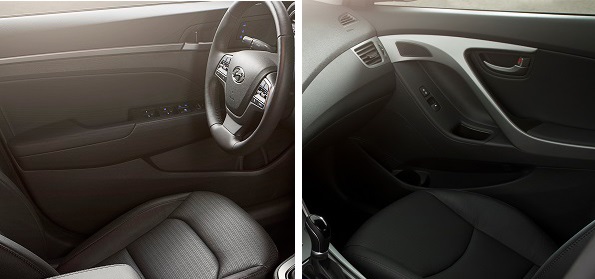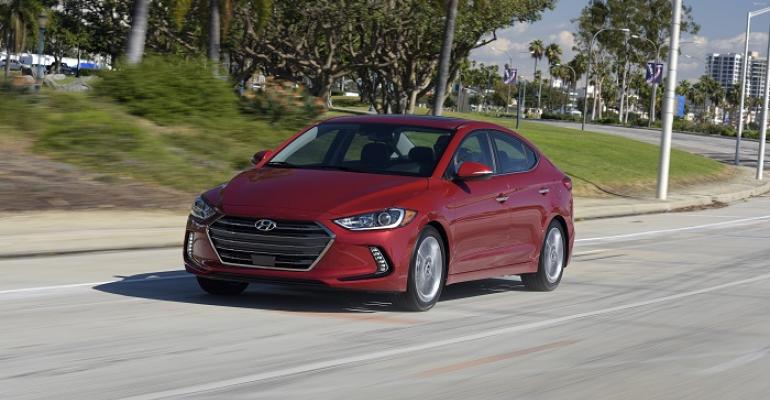IMPERIAL BEACH, CA – The problem with being a design innovator comes with, ‘What’s next?’
Hyundai knows that better than any automaker in recent memory.
It wowed the industry and D-car buyers alike with its ’11-’14 midsize Sonata, a car that had deeply-drawn stamped body panels and lots of curvy lines. It arrived like pinstriped pants in a sea of Dockers.
Then it wowed again with the compact ’11-’16 Elantra.
Thanks to the exterior and interior style of the outgoing C-sedan, the car caught the eye of more Americans than any Elantra before it.
Its perfect proportions, curvaceous exterior lines, sinuous headlights and taillights, and segment-above interior design and materials, propelled Elantra sales to double what they had been in the U.S.
In 2010, the car was fairly anonymous in the C-segment, with just 132,000 sales. Last year, sales hit 241,705, making it WardsAuto’s 7th best-selling car of 2015 and putting it in the same rarified air as Camry, Corolla, Accord, Civic, Altima and Fusion.
Hyundai decided to go in a different direction, a not-needing-to-shout-for-attention path, to paraphrase brand executives, with the ’15 Sonata.
Sales of the much-subdued car slumped.
Now the redesigned ’17 Hyundai Elantra, recently on sale at U.S. Hyundai dealers, may repeat the same scenario.
It wears plain sheet metal similar to the Sonata. What’s even worse for this interior aficionado is it has a bland passenger cabin, with lots of hard-plastic surfaces and not much pizzazz.
Fortunately it excels in other areas over its predecessor. Hyundai has much improved the car’s ride and handling, gave it a better base engine and increased the level of available safety technology. The interior is roomy, quiet and comfortable, too.
Stays Flat in Fast Curves
Here in some intense driving on mountain roads in rural San Diego County, the new car stays flat in fast corners, something that couldn’t always be said for the outgoing Elantra.
Hyundai credits updates to the torsion-beam rear suspension, specifically the switch from short-travel, reclined dampers to ones that are vertically angled and have longer travel, as enabling the car’s newfound planted-ness.
There’s also been an increase in rear-bushing diameter for better comfort, handling, stability and durability, Hyundai says.
The Elantra’s 147-hp, Atkinson-cycle 2.0L port-injected 4-cyl., which will be the car’s volume engine, also is a nice surprise. True, it doesn’t knock our socks off, neither here nor in our 2016 Wards 10 Best Engines testing last fall, but it is quieter than most of the competitive set.
Yes, as my fellow 10 Best Engines judge Tom Murphy states, the 2.0L is “thrashy at high rpm,” but at least it’s not thrashy at low rpm, a common C-car base-engine ailment.
The 2.0L is less raucous than the underpowered 1.8L 4-cyl. in the refreshed Nissan Sentra or the ’16 Civic sedan’s 1.5L direct-injected turbocharged four.
The Civic’s 2.0L port-injected I-4, the Honda’s base engine, has about the same level of noise at high rpms as the Elantra’s 2.0L.
Like Honda, Hyundai also will offer a DI turbo 4-cyl. in a compact car. But unlike Honda, Hyundai is putting its DI turbo mill, displacing 1.4L, in a near-base grade, the Elantra Eco. The lower price point naturally matches up with the coarser sound of some DI engines.
That sound is present in a quick jaunt in a pre-production Elantra Eco here, but we can forgive it considering we achieve nearly 40 mpg (5.9 L/100 km) without even trying.
For the 2.0L, piston-cooling jets, which spray oil at the piston’s skirt, and enable lighter-weight piston designs, are one of the measures that help improve fuel economy.
Hyundai estimates the ’17 Elantra Limited tested here and with the 2.0L engine paired to an updated version of its 6-speed automatic transmission will achieve 33 mpg (7.1 L/100 km) combined, up from a high of 32 mpg (7.4 L/100 km) in the outgoing 1.8L/6AT ’16 Elantra sedan.
On paper, Hyundai falls shy of the Civic, whose 2.0L I-4 and 1.5L turbo mated to a CVT return 35 mpg (6.7 L/100 km) combined. However, we are able to achieve 35 mpg in two long jaunts in Limited-grade Elantras, at roughly a 40-mph average (64 km/h).
The 1.4L Elantra Eco is estimated to achieve 35 mpg combined, but the grade will be a low percent of the overall mix.
Interior Disappoints
The previous-generation Elantra was a 2011 Wards 10 Best Interiors winner.
Our judges used phrases like “feast for the eyes” and “breathtaking design” when describing the car’s interior, which had a level of luxury we’d never seen before in a compact sedan.
Sadly, we can’t say the same for the cabin of the ’17 Elantra Limited.
Despite costing almost $28,000, the two Limited grades we drive here – with an Ultimate package that, as the name suggests, fully loads the vehicle with all manner of technology – feel like they have a price point closer to $20,000 than $30,000.
Door panels lack any soft-touch material at the top and for a design flourish get a thin, straight silver-painted strip emanating from the door handle, which has the same finish.
The outgoing Elantra had higher-end chrome door handles.
It also had gobs of silver-painted trim on its interior door panels, in the form of a generous, swooping plastic piece that flowed from the top to the middle of doors with a large grip in between.

One of our favorite features on the outgoing Elantra was the zebra-striped cloth seat fabric. It wasn’t as loud as it sounds, made up of two different textures of the same color.
The new Elantra fabric is a very subtle honeycomb-check pattern.
And while many automakers are using clever perforation arrays on ventilated leather seats, the look is too subtle in the new Elantra.
The hard-plastic surfaces have more sheen than before.
The corseted center stack is gone and its trapezoidal-shaped replacement is less distinctive.
But the Elantra’s center stack, much like the Sonata’s, is ergonomically better, with bigger buttons within easy reach of the driver.
Front and outboard rear seats are comfortable with a long lower cushion on front seats that adequately support a taller person’s thighs.
A big improvement to the interior is what you don’t hear. Engine, wind and road noise were more prominent in the outgoing model.
The new ’17 Elantra is much quieter inside, thanks to felt rear-wheel liners, smaller holes in the firewall for the steering column and wiring harnesses, denser foam and carpeting, as well as thicker door glass.
Hyundai’s internal testing shows interior engine noise from 2,000-6,000 rpm is heard at 67.1 decibels, lower than the new Civic or ’16 Mazda3 and Ford Focus.
The Elantra also leads on wind noise and noise at idle, while being usurped by the Focus and Mazda3 on road noise.
Hyundai is offering advanced safety systems in the $1,900 Ultimate package. Its lane-keep assist system is particularly impressive, with the Elantra’s steering wheel physically pulling us back in when we start to drift toward a lane line.
Smart cruise control and automatic emergency braking with pedestrian detection, features recently limited to luxury cars, also are included in the package.
Hyundai expects 2016 U.S. Elantra sales to repeat 2015’s roughly 240,000, as it reduces output of the car for the sake of the more in-demand Santa Fe CUV at its Montgomery, AL, assembly plant.
We can’t help but think those numbers are out of reach for the new Elantra, whose bland appearance, set off by a grille reminiscent of those seen on Ford models for the past five years, will make it difficult for lightning to strike twice.
'17 Hyundai Elantra Limited Specifications
| Vehicle type | 4-door, front-wheel-drive, 5-passenger compact car |
| Engine | 2.0L port-injected Atkinson-cycle inline 4-cyl., all aluminum |
| Power (SAE net) | 147 hp @ 6,200 rpm |
| Torque | 132 lb.-ft. (179 Nm) at 4,500 rpm |
| Bore x stroke (mm) | 81.0 x 97.0 |
| Compression ratio | 12.5:1 |
| Transmission | 6-speed automatic w/ Shiftronic |
| Wheelbase | 106.3 ins. (2,700 mm) |
| Overall length | 179.9 ins. (4,569 mm) |
| Overall width | 70.9 ins. (1,801 mm) |
| Overall height | 56.5 ins. (1,435 mm) |
| Curb weight | 2,811-2,976 lbs. (1,275-1,350 kg) |
| Price as tested | $26,875 (not incl. $835 destination and handling charge, SE begins at $17,150) |
| EPA Fuel economy | 28/37 mpg (8.4-6.4 L/100 km) city/highway |
| Competition | Chevy Cruze, Ford Focus, Honda Civic, Kia Forte, Mazda3, Nissan Sentra, Toyota Corolla, Subaru Impreza, Volkswagen Jetta |
| Pros | Cons |
|---|---|
| Lots of features for money | Doesn’t feel like $28k car |
| Comfy seats | Interior look downgraded |
| Smooth ride and handling, capable engine | Bland styling |





